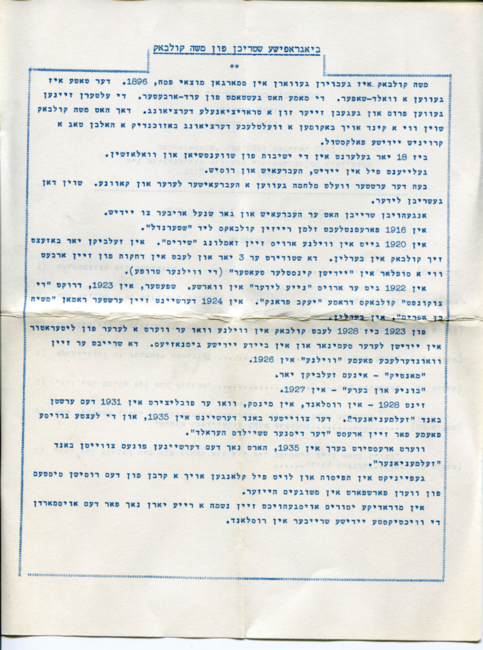The Zelmenyaners: Reading Resources
The First Reading Selection for the 2017 Great Jewish Books Book Club
Moyshe Kulbak’s The Zelmenyaners is many things: a family saga; a sometimes-earnest, sometimes-ironic portrait of the formative years of the Soviet Union and the Soviet pioneers; and a chronicle of modernity’s uneven arrival in Eastern Europe. For the first time, tramlines, movie theaters, and heavy industry begin to appear in the lives of Kulbak’s Jews—but many customs and patterns of Jewish life also begin to disappear. Kulbak, known primarily as a poet, is a brilliant storyteller, and the book manages the delicate act of being both serious and funny.
There are many interesting guides to The Zelmenyaners, reviews of the novel, and supporting materials of all kinds around the web. The original Yiddish novel is available in two volumes on our website: volume 1; volume 2. (A complete list of Kulbak’s books is available here. ) The Yiddish original is also available as an audiobook from our Sami Rohr Library of Recorded Yiddish Books.
In February 1975, an evening in honor of Moshe Kulbak was held at the Jewish Public Library in Montreal. The event, which was held in Yiddish and which you can listen to in our Frances Brandt Online Yiddish Audio Library, offers a comprehensive overview of Kulbak’s life and work. This sheet, a brief biography of Kulbak, was handed out at the event:

Today this sheet of paper is most interesting as ephemera. The most comprehensive English biography of Kulbak is his entry in the YIVO Encyclopedia. The Yiddish newspaper the Forverts (Forward) also made this short biographical video about Kulbak. The video is narrated by the former editor of the Forverts, Boris Sandler, in his beautiful Besserabian Yiddish. It features English subtitles:
A more intimate view of Kulbak appears in our Wexler Oral History Project. In this excerpt, the renowned scholar of Yiddish literature Benjamin Harshav describes what it was like to have Kulbak as a teacher:
The entire interview with Harshav is a treasure, and a brilliant introduction to the city Kulbak is most associated with, Vilna.
Although not explicitly about Kulbak, this clip from the Wexler Oral History Project provides added context. Kulbak was killed during Stalin's "great purges." Here, Ina Lancman, the daughter of a Soviet Yiddish author, shares her family's experiences during the purge:
But to return to The Zelmenyaners, several thoughtful reviews appeared at the time of the book’s publication. In a short, perceptive review, Rokhl Kafrissen called the novel “the funniest Yiddish novel about Soviet central planning you'll read this year.” At In geveb: A Journal of Yiddish Studies, Madeleine Cohen reflects on the novel’s stage: the hoyf, or courtyard, which served as the primary type of residence in Eastern and Central Europe for decades and which inspired much classic Yiddish fiction.
Also at In geveb, Sasha Senderovich (who edited the volume and wrote its introduction and notes) writes about the characters who make up the book’s central family, and the conversations between family members: “Instead of one Tevye confronting modernity during the waning years of Imperial Russia through encounters with his recalcitrant daughters, Kulbak creates four Tevye-like figures in the guise of the four ‘uncles’ in The Zelmenyaners.”
The article is accompanied by a fantastic illustration of the family tree sketched by one of Senderovich’s students.
Finally, we invite readers to listen to a conversation about the book between Senderovich and Sebastian Schulman, then-manager of the Yiddish Book Center’s translation programs, on the Center's podcast, The Shmooze:
